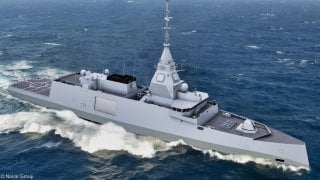Amiral Ronarc'h: France's New Navy Frigate Is Built to Sink Just About Anything
The French Navy's newest frigate, Amiral Ronarc'h (D660), has commenced sea trials, marking a significant milestone for the lead ship of a new class designed by Naval Group. This multipurpose warship, displacing over 4,400 tons and stretching 400 feet in length, is equipped with advanced weaponry, including two Sylver A50 8-cell Vertical Launching Systems.
What You Need to Know: The French Navy's newest frigate, Amiral Ronarc'h (D660), has commenced sea trials, marking a significant milestone for the lead ship of a new class designed by Naval Group. This multipurpose warship, displacing over 4,400 tons and stretching 400 feet in length, is equipped with advanced weaponry, including two Sylver A50 8-cell Vertical Launching Systems.
-Designed for versatility, it can engage in anti-surface, anti-submarine, and anti-air warfare, while also supporting special forces and unmanned systems.
-Delayed by the pandemic, the frigate is now expected to be commissioned in 2024. Four additional ships will follow, with some also being built for the Hellenic Navy of Greece.
First New French Navy Frigate Starts Sea Trials
The Maritime Nationale's (French Navy's) Amiral Ronarc'h (D660), the lead vessel of a new class of frigates designed and built by the French-based naval Group, began her sea trials this week. The first of a planned five warships, the D660 displaces just over 4,400 tons. The diesel-powered warship, which is also 400 feet in length, is armed with the two Sylver A50 8-cell Vertical Launching Systems (VLS), making for a fast and capable surface combatant.
As multipurpose warships, the new frigates can be employed in anti-surface warfare (ASuW), anti-submarine warfare (ASW), and anti-access/aerial denial (AA/AD), while also supporting Special Forces operations. The vessels can support unmanned aerial vehicles (UAVs) and unmanned surface vessels (USVs).
This new class of frigates was further designed with a digital architecture that allows for greater adaptability, while also being developed with protection from cyber threats.
The Admirals Class
Construction began on Amiral Ronarc'h, the First World War French admiral who commanded the Maritime Nationale's forces in the English Channel and later briefly served as Chief of Staff, began in 2019 with the cutting of the first steel.
However, due to the coronavirus pandemic and supply chain issues, the keel was only laid down in November 2021. There were subsequent delays during the fitting out, which pushed back the planned commissioning from 2023 to sometime next year.
Four additional frigates of the class will follow, with three of the five set to be in service by 2030. According to SeaForces.org, the Amiral Ronarc'h class will replace the Maritime Nationale's frigates "ship for ship," as the older warships are "considered to be insufficiently armed."
Each of the French frigates will be named for various admirals, and will include the Amiral Louzeau (D661) which is currently under construction and is set to be commissioned in 2027; Amiral Castex (D662) also under construction for commissioning a year later; while Admiral Nomy (D663) and Amiral Cabanier (D664) are both on order. The latter two vessels could be commissioned in 2031 and 2032 respectively.
Going Greek
An additional four of the French-designed frigates will be built for the Hellenic Navy, with assistance from the Greek maritime industry.
The first two are now being fitted out and include the Kimon (F-601) and Nearchos (F-602), and will also be commissioned in 2025, with the former likely happening in the first half of the year and the second later in the end. Earlier this year, modules were transported from Greece to the Naval Group's shipyard in Lorient for Formion (F-603), which could be commissioned in early 2026.
Athens has committed to a fourth frigate, Themistokles, but when construction could begin isn't known at this time.
About the Author: Peter Suciu
Peter Suciu is a Michigan-based writer. He has contributed to more than four dozen magazines, newspapers, and websites with over 3,200 published pieces over a twenty-year career in journalism. He regularly writes about military hardware, firearms history, cybersecurity, politics, and international affairs. Peter is also aContributing Writer for Forbes and Clearance Jobs. You can follow him on Twitter:@PeterSuciu. You can email the author: [email protected].
Image Credit: Creative Commons and/or Shutterstock.


